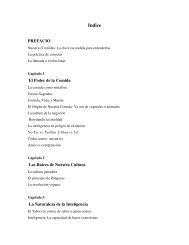The World Peace Diet: Eating For Spiritual Health And Social Harmony
The World Peace Diet: Eating For Spiritual Health And Social Harmony
The World Peace Diet: Eating For Spiritual Health And Social Harmony
You also want an ePaper? Increase the reach of your titles
YUMPU automatically turns print PDFs into web optimized ePapers that Google loves.
306 / the world peace diet<br />
37. “Top Ten Drugs of 2001,” Pharmacy Times, April 2002; 68(4), pp. 10–15.<br />
38. Mickey Z., “Pills a Go-Go,” VegNews, March–April 2003, p. 12.<br />
Chapter 12—Some Objections Answered<br />
1. Peter Kropotkin, Mutual Aid: A Factor in Evolution (New York: Penguin, 1939).<br />
2. Jim Mason, An Unnatural Order: Why We Are Destroying the Planet and Each<br />
Other (New York: Continuum, 1993), p. 72. See also Donna Hart and Robert W.<br />
Sussman, Man the Hunted: Primates, Predators, and Human Evolution (New York:<br />
Pereseus, 2005), p. 10.<br />
3. Hart and Sussman, p. 244. According to these anthropologists, early humans such<br />
as Australopithecus (2.5–7 million years ago) “depended mainly on fruits, herbs,<br />
grasses, and seeds, and gritty foods such as roots, rhizomes, and tubers. A very small<br />
proportion of [their] diet was made up of animal protein; mainly social insects (ants<br />
and termites) and, occasionally, small vertebrates captured opportunistically.”<br />
4. Mason, p. 70. According to fossil analysis carried out by M. Teaford and P. Ungar,<br />
“<strong>The</strong> early hominids were not dentally preadapted to meat—they simply did not<br />
have the sharp, reciprocally concave shearing blades necessary to retain and cut such<br />
foods.” (“<strong>Diet</strong> and the Evolution of the Earliest Hominids,” Proceedings of the<br />
National Academy of Science 97 (25): 13, p. 511.)<br />
5. Ibid., p. 81.<br />
6. Hart and Sussman, p. 190.<br />
7. Plutarch, “On <strong>Eating</strong> Flesh,” Moralia, William Watson Goodwin, ed. (London: S.<br />
Low, Son, and Marston, 1870), Volume 5, Tract 1.<br />
8. Peter D’Adamo, Eat Right for Your Type (New York: Putnam, 1996).<br />
9. <strong>For</strong> an overview of many of these, see Steven Rosen, <strong>Diet</strong> for Transcendence:<br />
Vegetarianism and the <strong>World</strong> Religions (Badger, CA: Torchlight, 1997).<br />
10. Keith Akers, <strong>The</strong> Lost Religion of Jesus (New York: Lantern Books, 2000), p. 117.<br />
11. See Matthew 15:11 through 15:20 for entire relevant passage.<br />
12. Matthew 15:19.<br />
13. Gary Zukav, Seat of the Soul (New York: Simon and Schuster, 1989), p. 276.<br />
14. Ibid., p. 278.<br />
15. See Marjorie Spiegel, <strong>The</strong> Dreaded Comparison: Human and Animal Slavery<br />
(New York: Mirror Books, 1999) for more on the treatment of black slaves as animal<br />
livestock in the standard practices of extreme confinement in transport, family<br />
destruction, branding, mutilation, and domination. See Sam Keen, Faces of the<br />
Enemy: Reflections of the Hostile Imagination (San Francisco: Harper & Row,<br />
1986) as well as his PBS documentary of the same name for more on how we<br />
humans have dehumanized people we intended to systematically harm (such as<br />
slaves and enemies), seeing them as sub-human—as animals. Keen shows, for<br />
example, how Nazi propaganda films equated Jewish people with rats, and U.S.<br />
<strong>World</strong> War II propaganda films and posters portrayed Japanese people as hordes<br />
of beetles, among other instances.<br />
16. Georgio Cerquetti, <strong>The</strong> Vegetarian Revolution (Badger, CA: Torchlight, 1997), p. 31.<br />
17. Ibid., p. 30.<br />
18. Howard Lyman, Mad Cowboy (New York: Scribner, 1998), p. 125.<br />
19. See Lynn Jacobs, Waste of the West, for a thorough discussion and reporting of the<br />
disastrous effects of cattle ranching in the American West. See also Howard Lyman,<br />
“Bovine Planet,” in Mad Cowboy, pp. 121–153.<br />
Chapter 13—Evolve or Dissolve<br />
1. Helen Caldicott, <strong>The</strong> New Nuclear Danger (New York: <strong>The</strong> New Press, 2002), p. 1.



